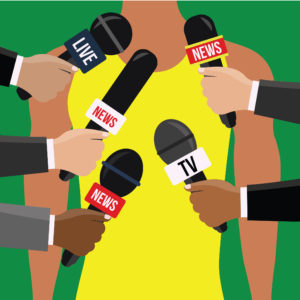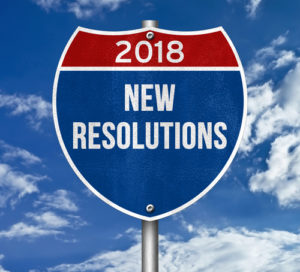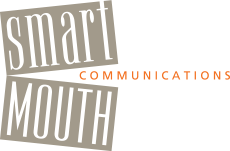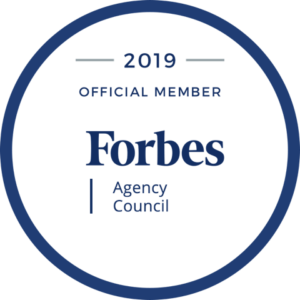SmartMouth Talks!
Verbal Wayfinding
I often wax on about audiences and audience-centricity: that you need to put your audience’s needs and interests ahead of your own, that it’s all about them, that they need tons of “guidance” in order to be able follow your presentation and get the point. All true. Perhaps never truer, as audiences have hand-held alternatives for their fickle feed-me-now attention spans.
 Guidance has always been a big one for me. Tell your audiences where you’re taking them, what you expect of them or want them to have at the end, when you’re digressing for a story, when you’re on main point #1, #2 or #3, and when you’re concluding. Don’t be afraid to speak your presentation structure out loud, so when an audience member’s attention drifts away, they’ll be able to track where you are when they bring their attention back to you.
Guidance has always been a big one for me. Tell your audiences where you’re taking them, what you expect of them or want them to have at the end, when you’re digressing for a story, when you’re on main point #1, #2 or #3, and when you’re concluding. Don’t be afraid to speak your presentation structure out loud, so when an audience member’s attention drifts away, they’ll be able to track where you are when they bring their attention back to you.
Two weeks ago, I was lucky enough to attend an executive speechwriting conference in Washington, D.C. Given the location, a lot of the speakers were from government and politics, but corporate America, higher education and healthcare were also nicely represented. There was a great cross-section of perspectives, experiences and standards shared by speakers and attendees alike. Friends and colleagues who knew I was going to the conference asked if I was speaking or attending. When I replied that I was attending and really excited to go and learn, I got some raised eyebrows.
Well, learn I did! I’ll admit it was gratifying when many of my methods and principles were validated by what I heard. But I’ll also readily admit that I took copious notes and brought back all kinds of new ideas.
Among those was “verbal wayfinding.” Verbal wayfinding is the more sophisticated term for guidance and is, in my view, a more well-developed concept. The other terms used interchangeably with verbal wayfinding were “breadcrumbs” and “signposts” – more than guidance, these refer to weaving into a speech or presentation thematic reminders and reinforcements as well as the structural ones that my word guidance encourages.
The bottom line is this: Your audiences have not seen your notes or read your script, nor have they rehearsed with you. They are fresh-earred, first-time listeners, and they will only hear it that one time. You and your material have shared countless moments together, but your audiences will share only one moment. It’s your job to make that moment count, make the material stick. Drop breadcrumbs throughout, put up signposts, script in verbal wayfinding, because it’s all about them, your audience, and they need guidance!
Non-Verbal Messaging
 All too often, in preparation for a speech or presentation, we focus on words and content, believing very sincerely in their importance. And I must confess, I am quite possibly more guilty of this than most.
All too often, in preparation for a speech or presentation, we focus on words and content, believing very sincerely in their importance. And I must confess, I am quite possibly more guilty of this than most.
So, in an effort to self-correct – and provide readers with valuable, necessary insights – I want to share some interesting facts about the importance of non-verbal communication:
-
Human communication is approximately 20% verbal and 80% non-verbal. This means if you’re saying something but your body language says the opposite, you’re not likely to get your message across. The focus on words and content is therefore lost.
-
According to researchers, our bodies express emotion better than our faces. Body language matters. It speaks volumes about us to others.
-
The average person actually only speaks words for a total of 10-11 minutes a day. And the average sentence takes 2.5 seconds to say. This, of course, is not the case for someone delivering a speech or presentation but is interesting to note in terms of other everyday communications.
-
We make and recognize about 25,000 facial expressions a day. Wow, that’s a lot of subtle, subconscious two-way communication.
-
Pointing is one of the most offensive gestures – and this is true pretty much around the globe.
-
Hand-steepling is one of the most high-confidence hand gestures. In general, hand and body gestures that move in an upward or out (toward your audience) direction register as positive.
-
Power poses – e.g. standing up, sitting with arms spread out on the on the chairs around you, “Wonder Woman” stance (feet planted; hands on hips) – make speakers feel more powerful as they actually change testosterone and cortisol levels in the body.
These are important insights to keep in mind, but you still need to be authentically you when you’re speaking in front of a group. We all have our own personal styles and preferences. Mine include moving around the room (as long as I don’t have a fixed podium mic), lots of eye contact, and gesturing out toward the audience. I smile a lot in one-on-one personal conversation, but I find that I have to make an effort to remember to smile when I speak publicly (go figure!).
Think about what your style and preferences are, and then identify one or two body language elements you might need or want to add. Try them, and good luck out there!
Proper Jock Talk?
“I want to go over to the judges and say, ‘Can I just have a Xanax and a quick drink?’” – Adam Rippon, U.S. Olympic Figure Skater.

What do you think of these quotes? Funny? Edgy? Whiny? Inappropriate? Authentic?
Are they simply sharing, self-revealing and being incredibly transparent?
Don’t get me wrong here. I, too, ADORE and IDOLIZE these two athletes. They both were amazing to watch, delivered incredible athletic performances and charmed the pants off of me and the rest of America in their interviews.
 However, I’m also a little old school about the Olympic Games and Olympic Athletes. While I encourage transparency and authenticity among my athlete and executive coachees, I believe the Olympics – more than any other sporting competition – call for a special kind of decorum. Athletes on the U.S. Olympic Team are not competing for a privately owned franchise, like an NBA or NFL team. These athletes are competing for the red, white and blue of the United States of America. The “brand” they represent is a complex mix of themselves, their sport/team and their country (not to mention, their sponsors, coaches and families). It’s a high bar to represent all of those entities well, but that’s what the Olympic Games demand.
However, I’m also a little old school about the Olympic Games and Olympic Athletes. While I encourage transparency and authenticity among my athlete and executive coachees, I believe the Olympics – more than any other sporting competition – call for a special kind of decorum. Athletes on the U.S. Olympic Team are not competing for a privately owned franchise, like an NBA or NFL team. These athletes are competing for the red, white and blue of the United States of America. The “brand” they represent is a complex mix of themselves, their sport/team and their country (not to mention, their sponsors, coaches and families). It’s a high bar to represent all of those entities well, but that’s what the Olympic Games demand.
For our part, the hero-worship is real and while we do want to know (and I do want them to share) what’s going on in their heads, especially prior to competition, I would prefer a little more careful selection in the words they choose. Little kids are watching, listening, modeling.
Having said that, I do recognize that both of these athletes meant to be self-effacing in these quotes versus the much-less-tolerable self-aggrandizing, and I applaud them for that. It’s also noteworthy that both of these quotes got a lot of positive attention. And in an almost immediate endorsement of his widespread appeal, Adam Rippon was offered a commentator position by NBC for the duration of the Games as soon as he finished competing. So there’s that too.
Perhaps I need to make an adjustment to my old-school thinking? Is there such a thing as “proper jock talk” for the Games? Let me know your opinion, I’m eager to hear what others think. I have until Summer of 2020 in Tokyo to change my outlook if necessary!
5-Point Memo to Olympians
To Team USA:
 Congratulations! You have achieved your dream, you are in PyeongChang now, and the Opening Ceremony is in two days. You are among the very best in your sport and you are so ready for the Olympic Games to begin.
Congratulations! You have achieved your dream, you are in PyeongChang now, and the Opening Ceremony is in two days. You are among the very best in your sport and you are so ready for the Olympic Games to begin.
But … are you ready for the Image Games?
Here are 5 points to remind you – and anyone who cares about their brand and reputation – how to view and play the media game:
1. Reporters have a job to do. They need to tell a story and include quotes to support the story. Without quotes, it would be an opinion piece. Sure, they get it wrong or twist things sometimes (usually unintentional) but, like you do with competition, stay focused and do your best to influence the outcome.
2. Play offense, not defense. Have an offensive strategy. Know how you like to talk about yourself, your sport, the competition, winning/placing/losing. Don’t play defense and simply wait for the questions to come at you only to have to think and respond on the fly. In other words, be prepared for what you know are the “usual suspect” questions.
3. Be gracious. About everything and everyone. At all times. Take the high road. Anything less sounds like sour grapes, sore winning/losing, or just plain ungrateful. Even if there’s a competitor that you and everyone else would like to pounce on, resist. On a world stage, in the spirit of sport and peace, give everyone the benefit of the doubt and stick to what you know best – yourself and your own performance. In the end, throwing shade on others casts more doubt on you than it does on them.
4. Be transparent. Be real. You are likely to be extremely real on social media, so be consistent when you talk to the traditional print and broadcast media. It’s okay to be vulnerable, emotional, frustrated or upset. Just own it and be gracious about it. Even crying is okay, everyone can empathize. The more real you are, the more accessible you are; the more accessible you are, the more your appealing you and your image are.
5. Maintain perspective. Everyone, spectators and reporters alike, would give anything to be in your shoes (or skis, skates, luge, bobsled) even for only 2 minutes. You, during these 16 days, are the darlings and envy of your country and the world. Reporters, because they get to be so close to you and the “field of play” for these 16 days, are especially prone to fandom. They’re there to be an insider as much as anything else, so keep that in mind. The only people looking to take you down are your competitors. Everyone else is pulling for you, even the media.
Bloviate
 Bloviate is a verb, usually attributed to the oral meanderings of politicians. It’s one of those words that sounds a lot like what it is – to blow hot air – or, according to the Oxford Dictionary, “to talk at length, especially in an inflated or empty way.” To blow hot air indeed.
Bloviate is a verb, usually attributed to the oral meanderings of politicians. It’s one of those words that sounds a lot like what it is – to blow hot air – or, according to the Oxford Dictionary, “to talk at length, especially in an inflated or empty way.” To blow hot air indeed.
Unfortunately, bloviating is not limited to the chambers of government. It happens in conference rooms and board rooms too. In fact, in some organizations, the bloviators are well known and their long-winded command of nothing is expected and – all too often – accepted as inevitable.
Well, in the interest of efficiency and effectiveness, I’m calling out those who bloviate and those who enable them. It’s time to stop – if not in the interest of efficiency (time) and effectiveness (getting things done), then in the interest of your audiences because their time and attention are precious commodities. Audiences may be clients, employees, partners, suppliers, regulators, stakeholders, or simply colleagues. No matter who they are, I’m willing to bet that not one of them appreciates, enjoys, learns from, or is impressed by a bloviator.
Following are a few of the ways in which people bloviate in meetings and what to do about it.
The floor hog. Yes, that one person who seems to love the sound of their own voice. Once they get the floor, it’s hard to wrestle it away from them.
The fabricator. This is the person who doesn’t know the answer to a question but keeps talking (and, to those more in the know, keeps digging the hole deeper).
The know-it-all. Smartest-person-in-the-room syndrome somehow never afflicts the person who is, in fact, the smartest person in the room. It’s usually someone who, for whatever reason, feels the need to puff themselves up.
The empty suit. This person may look the part but doesn’t know what they’re doing … or saying. And they don’t have the self-awareness or good graces to keep quiet.
Do these bloviating types sound familiar? I bet they do. And I bet your eyes rolled back in your head at least once. The fix is tough, though, because the common thread among these types is that they’re not audience-centric and therefore not good listeners or well-attuned to social cues (an understatement perhaps).
Given these limitations, neither being subtle nor confronting them as a means of correcting the behavior are likely to be very successful. It is therefore best to use behavior modification tactics. For example, try some of these:
- set and enforce strict meeting agendas with pre-assigned participants and pre-assigned allotments of time for each;
- select or assign a senior person to be the official interruptor of your bloviating colleague;
- if you can (i.e. in internal or informal meetings), call an abrupt end to the meeting once the hot air begins to blow; or
- if possible, stop inviting them to meetings.
Once it starts to affect their career opportunities and prospects, the bloviator might well sit up and take notice. Until then, it’s up to others to find ways to send the message not with the use of hot air but by taking action.
res·o·lu·tion rezəˈlo͞oSH(ə)n/
 Resolution. noun. A firm decision to do or not to do something.
Resolution. noun. A firm decision to do or not to do something.
Exactly. A firm decision to do or not to do something is exactly what’s required when we undertake any form of self-improvement – training, coaching, even meditation or a new workout regimen. Self-improvement is simply change, and all it requires is a firm decision to do something differently.
If you’re the New Year’s Resolution type, you’ve probably made yours already. But I’d like to suggest that resolutions – or decisions to make a change – can be undertaken at any time, not just at the start of a new calendar year. While I’m a big proponent of all forms of self-improvement – personal and professional – I’m obviously mostly concerned (okay, a little obsessed) with those that can improve your communication skills.
To that end, here are 3 examples of situations that could serve as prompts to help you recognize and make resolutions to be a better communicator/presenter/speaker at any time of the year:
1. You’re in the audience listening to a speaker who just crushed their opening or closing by doing something totally outside the box. Make a note to self, jot it down (this is where taking out your cell phone during an event is warranted!). Surely, you can adapt and adopt this technique once you decide that you, too, want to be a more impactful speaker.
2. A colleague shares specific feedback she got from the CEO following a meeting. She was applauded for how she choreographed the use of visuals with discussion points to engage everyone in the room. It’s something you’ve never done before but you know is doable with some forethought and planning. Note to self: practice and then try it going forward!
3. In a presentation to a client company, you address their challenges the way you always do. You also get the same questions you always get. Take a moment to reflect and ask yourself what you can do differently to preempt these questions. What is it about your approach that is leaving the same gap in understanding each time? Make the decision to do it differently the next time and design a new approach.
It’s okay to take your inspiration for change from the examples or hints from others, we do it all the time. Think about it this way; we’ve been modeling our own behavior on the behaviors and reactions of others much longer than we’ve been making New Year’s Resolutions!
How important are your slides?
 Given that 65% of the population are visual learners, using slides or other visual support during a presentation falls somewhere between being pretty useful and critically important. For the 65%, visual reinforcement enhances their ability to digest, process, and ultimately retain material.
Given that 65% of the population are visual learners, using slides or other visual support during a presentation falls somewhere between being pretty useful and critically important. For the 65%, visual reinforcement enhances their ability to digest, process, and ultimately retain material.
Then why is it, whenever I poll a group after speaking to them without using slides – “How many of you wish I had used PowerPoint today?” – zero hands go up. Always zero. No one misses PowerPoint.
Admittedly, I often use a white board and colorful markers to cement my key points, so I’m not eschewing visuals. And when the group I’m speaking to is large, I use PowerPoint so the slides can be projected onto a screen for everyone to see.
Generally speaking, though, people don’t like PowerPoint because it’s used poorly in many, if not most, cases. At the risk of nagging or sounding negative, here’s a top 5 list of PowerPoint “don’ts”:
1. Don’t use your slides as your presentation outline or script; they’re not for you, they’re for your audience!
2. Don’t use too many words on your slides; if your audience has a lot to read, they won’t be able to listen to you at the same time.
3. Don’t build your slides first; build your presentation outline first, complete with main points and supporting information, and then decide what kind of slides would support and reinforce them.
4. Don’t think you’re off the hook and don’t need to know/rehearse your presentation; if your your technology fails you in the room, you still have to deliver.
5. Don’t try to put everything you know in your slide deck; Microsoft named it PowerPoint, not EveryPoint.
The fact that the majority of people are visual learners underscores the importance of creating slides that are effective. At a minimum, use clean, clear graphics; memorable, relevant images; key words on text slides; and headings that tell audiences what they’re looking at and why. If you want to dig in more, there are lots of great resources available – not the least of which are Nancy Duarte’s books – to help you capture the 65% and along with them, the 35%.
Staying in Your Lane
If I had a dollar for every time I told a client, “well, that’s really not what this event calls for, attendees are coming for a celebratory occasion not a lecture” or “it’s not really your place to be talking about the speaker’s topic, you’re simply introducing them” or “what you’re describing you want to talk about is more appropriate for an external audience rather than an internal one,” I could retire!
 Speakers and presenters veer out of their lanes all the time. It’s as though an invitation to make a few remarks confers responsibility for the entire event on them. Or they feel as though, given the opportunity, they need to be as comprehensive as possible. Not so.
Speakers and presenters veer out of their lanes all the time. It’s as though an invitation to make a few remarks confers responsibility for the entire event on them. Or they feel as though, given the opportunity, they need to be as comprehensive as possible. Not so.
Here are 3 tips to help you stay in your lane:
1. Know your job. For every occasion when you need to speak, you have a “job.” By job, I mean a communication task: you might need to motivate, persuade, reassure, inform, update, or even introduce. There’s always a verb that describes your job, you might even have a primary and a secondary job. Knowing your job helps you paint the boundary lines of your lane. As you prepare your remarks, all you need to do is test what you’re planning to say against your job and stay inside those boundary lines.
2. Be #audience-centric, have perspective. Have you ever been to a fundraising gala, basically a party, where everyone is dressed up, having fun, socializing at tables with friends, and then the buzzkill comes – long narratives from the microphone about the organization’s serious work (and let’s be honest here, no one’s paying attention)? Yes, the work is important and yes, there’s a captive audience; but no, now’s not the time for the laundry list of “what we do.”
Or, have you ever gone to hear a special speaker and the person who introduces them not only delivers a nice intro, but then offers their own spin or summary on the speaker’s topic? To be polite, this is not only unnecessarily repetitive but it’s also not what the audience came to hear. To be less polite, this is inappropriate, often making audience members impatient and annoyed.
Perspective is key to staying in your lane. Perspective requires you to be audience-centric – to put the audience’s needs and experience ahead of your own. Without it, you risk alienating the audience.
3. Err on the side of #brevity. When in doubt, be brief – no one has ever annoyed or alienated an audience by being brief. If you’re not sure of your job or your lane, put your energy and efforts into being short and sweet. Sometimes speakers swerve out of their lanes because they’re not clear on who is supposed to say what and they want to make sure they cover everything. I hear you, I get it. Still, either coordinate with the other presenters ahead of time and/or let your audience ask you if they need more.
At the end of the day, it’s all about them – your audience. Stay in your lane so you don’t hit them!
Authenticity Over Accuracy
I want to share a personal story that’s not entirely flattering. In fact, the episode was a little bit jolting at the time, but soon thereafter it reaffirmed two important aspects of my coaching and training philosophy:
When it comes to audiences, always connect with them and always learn from them.
So, here’s the story …
A few years back, I was invited to be the guest speaker at an open house for a Toastmasters chapter. It wasn’t a regular Toastmasters meeting, it was a membership cultivation event. I was asked to speak on the importance of having a big idea and how to identify and articulate one.
I’m a fan of Toastmasters and, in fact, recommend it to clients who need lots of practice speaking, usually to desensitize them to the fear of public speaking. The event was quite interesting, it drew a very diverse crowd of people, and the Toastmasters members and leaders were very welcoming. I gave my talk, which I had prepared ahead of time (I always prepare ahead!), I kept it brief (I always try to be brief!), and there was a robust Q&A.
 When I was done, I got great feedback and lots of thank you’s from the audience. However, on my way out the door at the end of the event, one of the chapter leaders approached me with his clipboard. Apparently, he had been scoring me while I was speaking, and it turns out I didn’t do so well by Toastmasters’s standards. He had counted um’s and ah’s (thankfully there weren’t too many), and he had timed, measured, and scrutinized me for public speaking metrics that weren’t on my radar screen.
When I was done, I got great feedback and lots of thank you’s from the audience. However, on my way out the door at the end of the event, one of the chapter leaders approached me with his clipboard. Apparently, he had been scoring me while I was speaking, and it turns out I didn’t do so well by Toastmasters’s standards. He had counted um’s and ah’s (thankfully there weren’t too many), and he had timed, measured, and scrutinized me for public speaking metrics that weren’t on my radar screen.
Admittedly, I went in unfamiliar with the methodology of Toastmasters. Still, my initial reaction to the sudden appearance of the clipboard felt like a breach of hospitality – that without any forewarning, an invited guest would be scored and critiqued? I was taken aback, and my ego was bruised. I recovered quickly, though, and my reflection on the experience reaffirmed two things for me:
First, with all due respect to Toastmasters, being an effective speaker is less about precision and more about being real and connecting with people. In my practical experience, being real and accessible goes a lot farther than pitch perfect delivery. Audiences are pretty forgiving and they’re also hungry to be let in, to feel like they know and can identify with the speaker – warts and all.
Second, that we can always learn from our audiences and, in reality, we always do. Every interaction with a client and every speaking engagement informs and sharpens my approach. I always say that my clients are my greatest teachers. The trick is to look for those lessons, be open to them and consciously make a note-to-self about what you plan to do differently or better next time.
To this day, I encourage clients to try Toastmasters – for nerves, um’s and ah’s, and just for muscle practice. It’s all good. Nonetheless, there’s a good case for authenticity over accuracy, and there’s also a good case for letting others teach you, even when it’s unexpected or uncomfortable.
Prepared Presentations: 2 Lessons
I went to a storytelling event a week ago Friday night. It was cast as lovingly competitive, meaning the audience gave huge amounts of support and encouragement to each volunteer storyteller – whose names were pulled out of a bowl – but there were teams of judges and (friendly, gentle) scoring.
The event was sold out and not until about halfway through did I realize that a lot of people in that packed room had come prepared with a story and put their names in the bowl hoping to be selected. And there I found myself, purely a spectator, in a room of would-be storytellers, which made me ponder whether I would be willing to do this sometime – after all, I coach people on storytelling (albeit usually for business audiences) – and, if not, why, which is an entirely different topic!
Apart from being wildly impressed and deeply touched by the 10 people who were willing to “put themselves out there,” I was struck by two things about prepared presentations, which I want to share as both are extremely informative lessons.
First, writing out a presentation, memorizing and then delivering it does not sound natural; it sounds like you wrote it out, memorized and then delivered it.
There are certain words or phrases – e.g. “irrespective of” or “after careful consideration” – that work great when you write them and a reader reads them but honestly, they sound stilted when you say them (unless, of course, you’re in a courtroom or some other formal setting).
Writing out your thoughts to prepare a story or presentation is great, but you’ll need to fine-tune your draft by speaking the words out loud to make sure you sound like you’re talking – and, in the case of storytelling, like you’re talking off the cuff, as if you’re sharing with friends.
It’s not that memorization itself is bad or wrong, it’s that you need to memorize the right words, words that fit the occasion and sound natural. In the case of storytelling, those words should sound more chatty than dissertation-like.
Second, you can kill the impression an audience has of your perfectly great presentation by running over your allotted time.
 So at this event, I loved that the timekeeper used a harmonica to alert both the storyteller and audience that the allotted 5 minutes was up … and then 5 minutes 30 seconds … and finally, 6 minutes. At 5 minutes and 5 minutes 30 seconds, the harmonica merely chimed in to give a friendly nudge; at 6 minutes, the harmonica played until the storyteller wrapped it up.
So at this event, I loved that the timekeeper used a harmonica to alert both the storyteller and audience that the allotted 5 minutes was up … and then 5 minutes 30 seconds … and finally, 6 minutes. At 5 minutes and 5 minutes 30 seconds, the harmonica merely chimed in to give a friendly nudge; at 6 minutes, the harmonica played until the storyteller wrapped it up.
One young woman was telling a pretty interesting and suspenseful story when the harmonica hummed the first signal. I wondered how close she was to the end, and I was eager to hear what the moral was going to be. When the harmonica hummed the second time, I actually started to feel anxious for her, I still wondered if she was close to her conclusion, and I still was pulling for her. At 6 minutes, with the harmonica playing background music to her increasingly speedy delivery, I forgot all about the interesting, suspenseful story, I forgot about my empathy for her and the telepathic encouragement I was sending her, and instead, I found myself (perhaps a bit too harshly) thinking she just bombed. Ouch!
Going over time is buzzkill. Audiences just don’t tolerate it very well. In your preparation, you’d be wise to leave a cushion for yourself and plan to take less time than you’re allotted. No one has ever complained about a speaker who finishes early!



